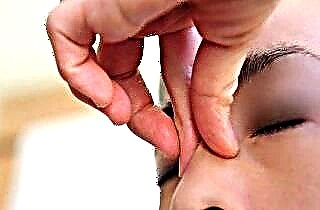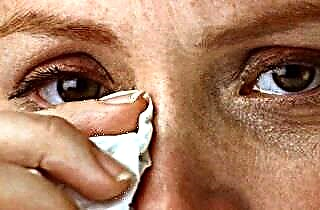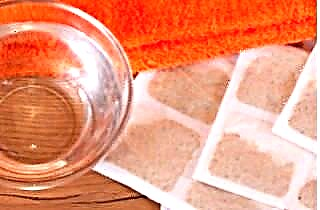Symptoms of curvature of the nasal septum occur in most of the inhabitants of the planet. This violation has negative consequences if it is not eliminated in time. To alleviate the patient's condition, physiotherapy procedures and folk remedies, massages can be used, but the problem can be completely eliminated only with the help of an operation. To recognize the disease in time, you need to know how it manifests itself.
Why curvature occurs
 When a person is just born, his nasal septum in most cases is perfectly flat. It consists of cartilaginous tissue in which small areas of ossification are located. With age, by about 10-12 years, a full-fledged septum is completely formed, the bottom of which consists of cartilage, and the top is made of thin bone. Ideally, it is flat and divides the nose into two approximately equal sections. This is necessary for the normal regulation of air temperature, its humidification, release from foreign bodies and transport of oxygen to the alveoli.
When a person is just born, his nasal septum in most cases is perfectly flat. It consists of cartilaginous tissue in which small areas of ossification are located. With age, by about 10-12 years, a full-fledged septum is completely formed, the bottom of which consists of cartilage, and the top is made of thin bone. Ideally, it is flat and divides the nose into two approximately equal sections. This is necessary for the normal regulation of air temperature, its humidification, release from foreign bodies and transport of oxygen to the alveoli.
Disruption of the growth of bone and cartilage tissue, the presence of neoplasms in the nasal cavity and injury can lead to a curvature of the septum. Let's consider in more detail the classification of the reasons for the violation.
- Physiological. During the period of active growth of the facial and cerebral parts of the skull, an uneven increase in bones and cartilage can be observed. When the nose grows rapidly and the skull slowly, it does not have enough room for normal development, therefore, it bends in one direction or another. There are also situations when there is an uneven growth rate of bone and cartilage tissue. This leads to the fact that the septum is bent, growths appear on it.
- Traumatic. This is the most common cause of deformation. At the time of injury, the bones break and the cartilage is displaced. Such violations may not make themselves felt at all for a long time, but in old age they cause serious pathologies. Trauma can be inflicted not only on an adult, but also on a child during childbirth.
- Compensatory. The presence of various neoplasms in the nasal cavity leads to a curvature of the septum. The mechanism of occurrence of the violation is very simple, a tumor or polyp creates additional pressure on the cartilage, due to which they are deformed.
Symptoms of the violation
The patient often does not even suspect that he has a problem, since it is not always visualized. However, the curvature of the nasal septum causes symptoms that may indicate pathology. There are such signs of deformation:
 Breathing problems. An irregularly shaped nasal septum makes it difficult for air to pass through the upper respiratory tract. However, there are cases when this symptom does not exist at all in case of violation. This happens if the curvature occurred a very long time ago, over time, the body starts a compensatory function and can adapt to deformation. If the pathology is serious, then shortness of breath may occur in one of the nostrils.
Breathing problems. An irregularly shaped nasal septum makes it difficult for air to pass through the upper respiratory tract. However, there are cases when this symptom does not exist at all in case of violation. This happens if the curvature occurred a very long time ago, over time, the body starts a compensatory function and can adapt to deformation. If the pathology is serious, then shortness of breath may occur in one of the nostrils.- Rhinitis. Patients often confuse signs of deformity with colds. When curving, the air does not pass evenly along the passages, it creates vortices. At the site of the impact of this flow, the cilia of the epithelium gradually die off. This causes dysfunction of the mucous membrane, the vessels in it dilate, edema appears and a constant or episodic secretion of mucus begins. In addition, local immunity is impaired, the nose becomes vulnerable to infections.
- Allergy. With the loss of the protective functions of the nasal mucosa and its constant irritation, allergic reactions develop. They are manifested by tearing, sneezing and a persistent runny nose. It is characteristic that rhinitis appears only upon contact with dust, pollen, animal hair and other agents. He is a harbinger of bronchial asthma.
- Reflex headache. Nerve receptors located in the nose can become irritated by contact with the growths and bulges of the septum. This leads to headaches, which can be short-term or persistent.
- Dry mucous membranes. Under the influence of the inflammatory process, which provokes deformation of the septum, the mucous membrane is depleted and the production of secretion is disrupted. This causes dryness.
- Bleeding. From the side of the bulge of the nasal septum, the mucous membrane becomes very thin over time, it can be damaged even with slight mechanical stress. The morning toilet or the slightest blow leads to nosebleeds.
- Snoring and sleep apnea. A deviated septum leads to impaired breathing during sleep. When inhaling and exhaling, characteristic snoring is heard, sleep apnea is rarely observed - a condition in which breathing stops completely, and then resumes, but becomes too frequent and intermittent.
 Violation of the olfactory function. When the curvature is based at the top of the septum, it becomes difficult for oxygen to reach the olfactory center. Disorder of the trophism and blood circulation of the olfactory nerve leads to respiratory or essential (irreversible) loss of smell.
Violation of the olfactory function. When the curvature is based at the top of the septum, it becomes difficult for oxygen to reach the olfactory center. Disorder of the trophism and blood circulation of the olfactory nerve leads to respiratory or essential (irreversible) loss of smell.- Oxygen starvation. Gas exchange in the alveoli of the lungs occurs normally only if the body receives a sufficient amount of oxygen. When the septum is curved, the flow of air is difficult, it is not enough for the normal supply of all organs. This leads to oxygen starvation, the signs of which are:
- fast fatiguability;
- decrease in mental and physical capacity for work;
- decreased concentration and memory;
- loss of tone.
- Violation of the form. A crooked nose indicates that the septum is deformed. Visual signs indicate serious problems that need to be addressed as quickly as possible.
- Decreased hearing. The nose and the Eustachian tube are interconnected by the nasopharynx, it is on its mucous membranes that the pharyngeal openings of the auditory tubes are located. This means that with constant infection of the nasal mucosa, pathogenic microorganisms very quickly penetrate into the tympanic cavity or auditory tube.
- Frontitis and sinusitis. Inflammation of the frontal sinuses, maxillary or maxillary sinuses can develop from curvature of the septum. Infections, which the nasal mucosa cannot fully resist, invade the paranasal sinuses and cause chronic sinusitis.
- Inflammation of the lacrimal sac. The infection can easily penetrate from the nose into the lacrimal duct, since under normal conditions the tears produced by the lacrimal glands swell into the nasal cavity through the nasolacrimal canal. If the nasal mucosa is infected, the lacrimal sac becomes infected.
 Epileptic seizures. Seizures happen quite often, as the patient does not have enough oxygen, his nasal mucous membranes are swollen and cannot cope with the flow of air into the nose.
Epileptic seizures. Seizures happen quite often, as the patient does not have enough oxygen, his nasal mucous membranes are swollen and cannot cope with the flow of air into the nose.- Violation of the menstrual cycle. In women, against the background of deformation of the septum, dysmenorrhea occurs. This is a condition in which the frequency and duration of menstruation changes every time, a complete failure occurs in the cycle.
- Choking attacks. Obstruction of the nasal passages can lead to short-term spasm, causing suffocation. Most often, this symptom appears when the patient takes a horizontal position.
- Malfunction of the cardiovascular system. A curved septum leads to oxygen starvation and circulatory disorders.These disorders provoke an increase in blood pressure and various problems with the heart muscle.
Assisting the patient
If at least one of the symptoms of a disorder is found, you should consult an otolaryngologist. The doctor will find out which areas of the nose have succumbed to deformation, what type of curvature the patient has, and what concomitant diseases need to be treated for full recovery.
 The doctor obtains data with the help of such studies: anterior rhinoscopy (through the nose), posterior rhinoscopy (from the choanal side through the mouth), radiography, computed tomography, endoscopic examination (using a special probe).
The doctor obtains data with the help of such studies: anterior rhinoscopy (through the nose), posterior rhinoscopy (from the choanal side through the mouth), radiography, computed tomography, endoscopic examination (using a special probe).
In addition, laboratory tests such as a general blood test to determine infections, cytology of a smear and mucus taken from the nasal cavity, bacterial culture are carried out. Consultation with an immunologist is necessary to determine violations of the body's protective functions. In case of signs of allergy, allergy tests are prescribed, they are necessary to identify pathogens of personal intolerance.
These studies help the doctor find out the degree of the disorder and its nature, learn about the presence of concomitant diseases. It is pointless to treat the curvature with the help of massages and other procedures, only a special operation will help.
Before surgery, you can use medications and folk remedies that alleviate the symptoms, but they will not be able to completely get rid of the problem with their help.
Treatment features
There are several methods of performing the operation, which the doctor should choose. After a thorough examination, the patient is assigned the day of the operation, however, contraindications may also be identified for it. Correction is carried out using a laser, classical or endoscopic surgery. The laser technique is best used, as it requires a shorter rehabilitation period and immediately seals the vessels in the nose, which prevents swelling and bleeding.
However, surgery may be contraindicated if you have certain medical conditions that your doctor will tell you about.
Conclusions
The curvature of the septum in the nose may not disturb the patient at all for a long time. However, with age, it makes itself felt with serious symptoms. There is no prophylaxis against this disorder, all that can be done is to prevent injury to the nose.
If you find any signs of deformation, you should immediately consult a doctor to avoid complications. Only surgical intervention will help patients to completely get rid of the problem; it is carried out according to different methods. Also, treatment is prescribed for all concomitant ailments that could be triggered by deformation.

 Breathing problems. An irregularly shaped nasal septum makes it difficult for air to pass through the upper respiratory tract. However, there are cases when this symptom does not exist at all in case of violation. This happens if the curvature occurred a very long time ago, over time, the body starts a compensatory function and can adapt to deformation. If the pathology is serious, then shortness of breath may occur in one of the nostrils.
Breathing problems. An irregularly shaped nasal septum makes it difficult for air to pass through the upper respiratory tract. However, there are cases when this symptom does not exist at all in case of violation. This happens if the curvature occurred a very long time ago, over time, the body starts a compensatory function and can adapt to deformation. If the pathology is serious, then shortness of breath may occur in one of the nostrils. Violation of the olfactory function. When the curvature is based at the top of the septum, it becomes difficult for oxygen to reach the olfactory center. Disorder of the trophism and blood circulation of the olfactory nerve leads to respiratory or essential (irreversible) loss of smell.
Violation of the olfactory function. When the curvature is based at the top of the septum, it becomes difficult for oxygen to reach the olfactory center. Disorder of the trophism and blood circulation of the olfactory nerve leads to respiratory or essential (irreversible) loss of smell. Epileptic seizures. Seizures happen quite often, as the patient does not have enough oxygen, his nasal mucous membranes are swollen and cannot cope with the flow of air into the nose.
Epileptic seizures. Seizures happen quite often, as the patient does not have enough oxygen, his nasal mucous membranes are swollen and cannot cope with the flow of air into the nose.

